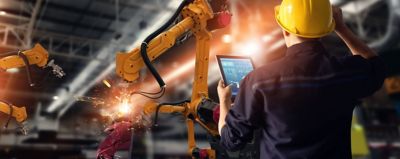If you're researching air compressor models, and wondering "how does air compression work?" You are in the right place. This guide walks you through various aspects of air compression, including treatment and types of compressors. Of course, if you find yourself needing further information throughout this article, you can always reach out to our knowledgeable team.
Contact us today to learn more about air compression and the equipment we offer.
Read on to learn more about:
● What is compressed air?
● How does air compression work?
● Types of air compressors
● Compressed air applications
● A complete solution
What is compressed air?
Simply put, compressed air is just normal air that has a higher pressure than what we breathe. It's contained in a tight space and gets released at high speeds. This is due to the atmospheric imbalance of the compressed air.
With this, there's a wide range of possible pressure levels, depending on how quickly the air is pressurized in relation to its container volume.
When comparing compressor models, you'll likely see the pressure expressed in bar, which measures atmospheric pressure. Alternatively, it is measured in pounds per square inch (psi).
You’ll also see flow mentioned to represent the amount of air a compressor is able to produce at a specific pressure. This is expressed in cubic feet per minute (cfm), liters per second (l/s) or cubic meters per hour (m3/h). It’s important to pay attention to these ratings to ensure your equipment is compatible with your desired application(s).
Investing in a compressor that's too big or small results in inefficient and/or unreliable operations.
How does air compression work?
As mentioned above, air compression uses normal air. This air is rapidly sucked in through a tight space via a compression element. The result is air that’s more dense than atmospheric conditions.
With air compressors an inlet, motor, element (air end), and storage tank is typically used to generate compressed air. This can happen with various methods and is why multiple types of compressors exist.
Air treatment
Since ambient air is used during compression, air treatment is usually necessary to obtain high-quality air for your application(s). This is because air in our environment typically contains dust and other particles. Also, the compression process can add contaminants like oil and moisture. Due to this, it's advised to invest in filters, dryers, and other equipment to counteract such impurities.
Dryers
Dryers are important because of the various temperature changes compressed air goes through. As the air rapidly moves through a compressor, it tends to become hot. This heat brings humidity and moisture. It's important to prevent this, as it can cause rust and corrosion within your compressor and your air system.
To reiterate, a complete compressor setup with air treatment equipment is highly recommended for maintaining peak operations.
Types of air compressors
There are two main types of compressors you'll encounter when exploring options. These are piston compressors and rotary screw compressors.
The fundamental difference between these two types is how they operate. A piston machine typically uses a motor and crankshaft to move pistons within a cylinder (or cylinders). Rotary screw compressors, on the other hand, compress air with two opposing rotors, which can be powered by a wide range of engines.
Piston vs. rotary screw compressor
There are advantages and disadvantages to both compressor types. Piston compressors have a much simpler design, making them easier to maintain. They also have a lower initial investment cost.
As implied, rotary screw machines are more expensive to buy. That said, they offer higher energy efficiency benefits which usually make up for the higher investment cost.This is due to their more complex engine design, and technological advancements.
Variable speed drive
One of the key differences between piston compressors and rotary screw equipment is variable speed drive. This option, offered by rotary screw compressors, allows one machine to provide various air flow levels. This is made possible due to how a variable speed drive motor adapts its speed depending on air demand. Variable speed technology results in energy savings of up to 45%.
Compressed air applications
There is a wide range of applications where compressed air is used. With these, it's also worth considering air quality levels. It's recommended to check which ISO 8573-1 class matches your application. This will help determine the right filters, dryers, and other treatment equipment to use.
Below you'll find a list of where compressed air is commonly found:
● Pneumatic tools
● Food and beverage
● Medical
● Pharmaceutical
● Automotive
● Construction
Get tailored advice
Still have questions after reading? Our expert is ready to help you make sense of it all and guide you to the best solution.
Write to an Expert Today – Get the answers you need.






